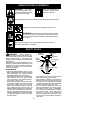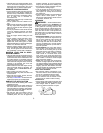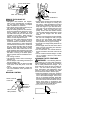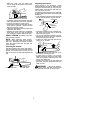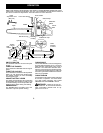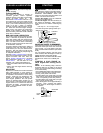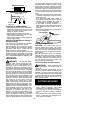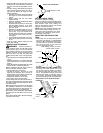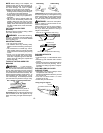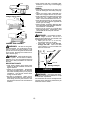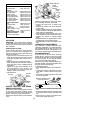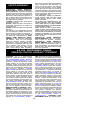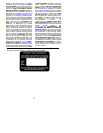
11
S
Keep thechainout ofdirtand sand. Evena
small amount of dirt will quickly dull achain
and thus increase the possibility of kick-
back.
S
Practice cutting afew small logs using the
following techniques to get the “feel” of us-
ing your saw before you begin a major
sawing operation.
S
Squeeze the throttle trigger and allow
the engine to reach full speed before
cutting.
S
Begin cutting with the saw frame
against the log.
S
Keep the engine atfull speed the entire
time you are cutting.
S
Allow thechain tocut foryou. Exert only
light downward pressure. If you force
the cut, damage tothe bar,chain, oren-
gine can result.
S
Release the throttle trigger as soon as
the cut is completed, allowing the en-
gine to idle. If you run the saw at full
throttle without a cutting load, unneces-
sary wear can occur to the chain, bar,
and engine.
S
Toavoid losing control whencutiscom-
plete, donotput pressureonsawatend
of cut.
S
Stop the engine before setting the saw
down after cutting.
TREE FELLING TECHNIQUES
WARNING:
Check for broken or
dead branches which can fall while cutting
causing serious injury. D onot cutnear build-
ings orelectrical wires if you donot know the
direction of tree fall, norcut atnight since you
will not be ale to see well, nor during bad
weather suchas rain, snow,or strong winds,
etc.
S
Carefully plan yoursawingoperation i nad-
vance.
S
Clearthe w orkarea. You needacleararea
all around the treeso you can havesecure
footing.
S
Study the nat ural conditions that can cause
the tree to fall in a particular d irection.
Natural conditions that can cause a tree to
fall in a particular direction include:
S
The wind direction and speed.
S
The lean of the tree. The lean of a tree
might not be apparent due to uneven or
sloping terrain. Useaplumb orlevel to de-
termine the direction of tree lean.
S
Weight and branches on one side.
S
Surrounding trees and obstacles.
Look for decay and rot. If the tr unkis rotted, it
can s nap and fall towar d the operator. Check
for broken or dead branches which can fall on
you w hile cutting.
Make sur e ther e isenough room for thetreeto
fall. Maintain a d ista n c e of
2-1/2
tree lengths
from t he nearest person or o ther objects. En-
gine noise can drow n out a w ar ning cal l.
Removedirt, stones, loosebark, nails, staples,
and w ire from the tree where cuts a r e to be
made.
Plan a clearretreat pat hto therear and diag-
onal to the line of fall.
Direction of Fall
45
_
Plan a clear retreat path
FELLING LARGE TREES
(6 inches in diameter or larger)
The notch method is used t o fell large trees.
Anotch iscut onthe side ofthe treeinthede-
sired direction of fall. After a felling cut is
made on the opposite side of tree, the tree
will tend to fall into the notch.
NOTE:
If the tree has large buttress roots,
remove them before making the notch. If
using saw to remove buttress roots, keep
saw chain from c ontacting ground to pre-
vent dulling of the chain.
NOTCH CUT AND FELLING THE
TREE
S
Make notch cut by cutting the top of the
notch first. Cut through
1/3
of the diameter
ofthetree. Nextcomplete the notch bycut-
ting the bottom of the notch. See illustra-
tion. Once the notch is cut remove the
notch of wood from the tree.
Notch
First cut
Second cut
Final (felling) cut here. 2 inches
above center of notch.
Hinge
S
After removing the cutout of wood, m ake
the felling cut on the opposite side of the
notch. This is done by making a cut about
two inches higher than the center of the
notch. This will leave enough uncut wood
between the felling cut and the notch to
form a hinge. This hinge will help prevent
the tree from falling in the wrong direction.
Opening
of felling
cut
Closing of
notch
Hinge holds tree on stump and helps
control fall



